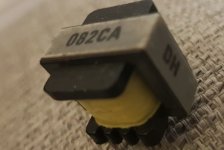Generally speaking, the horizontal, not vertical, output transistor is driven by a small transformer. Its ratio is typically in the order of 10:1 and its short secondary winding feeds the base & emitter terminals of the horizontal output transistor, so if you check these on a meter, they will measure like a dead short which is normal. The small transformer that you have shown is much more likely part of the horizontal scan stages than the vertical scan stages.
The vertical scan stage architecture, be it IC based, or discrete transistors, is normally much easier to fault find than the horizontal. Really it is just a power amplifier, not dissimilar to an audio power amplifier, amplifying a sawtooth drive wave to feed the vertical scan yoke coils.
Sometimes, a manufacturer will use a scan IC, just for its sync separator & oscillator sections, and rather than using the IC's internal power output stage, feed the sawtooth signal to a separate transistor based output stage. That could possibly explain why the output of that IC, on pin 15, appeared to be not connected. I will look up that IC.....
looking at the data sheet, they may well have taken the vertical ramp signal from pin 16, to feed a different type of output stage than the one shown on the schematic. This IC contains the oscillators for both the H & V scan.
As can be seem from their example schematic, the yoke's current is sampled by the voltage developed across the 4.7R resistor, this is fed back, from the output stage driving the yoke to pin 16, via the size control, so when all was working, there would be an approximate sawtooth wave on pin 16. But it would pay to check pin 15 again just in case there is a track connected to it under the IC that is hard to see, if it is a multi layer pcb. From what I can see with this IC it would be likely they used pin 15.
In any case, rather than just stabbing in the dark, the better method is to get the IC data sheet, and example circuit there as a guide, and then start to draw out the schematic from the pcb. The modules probably won't be a problem because it will likely be self explanatory what they are supposed to be doing when the schematic is drawn out and they could be re-generated as discrete parts. Often "modules" were used for the Vertical sync pulse integrator and there were just a string of resistors and capacitors to ground to make an LPF.

